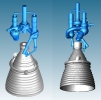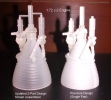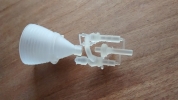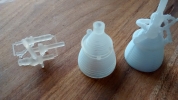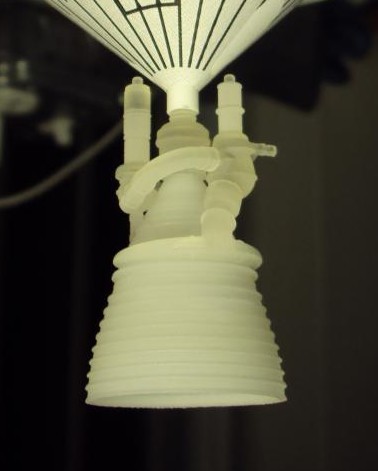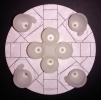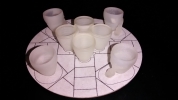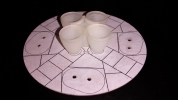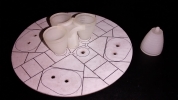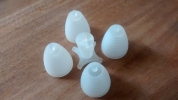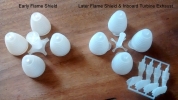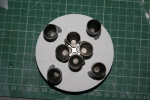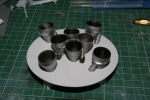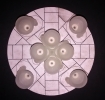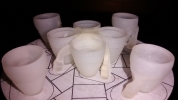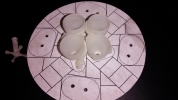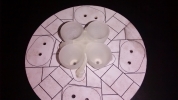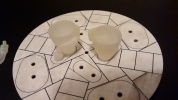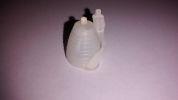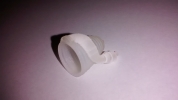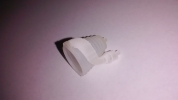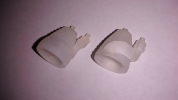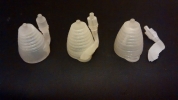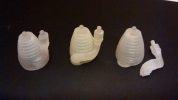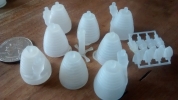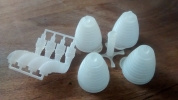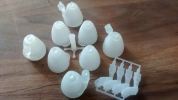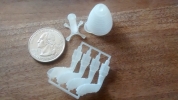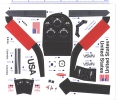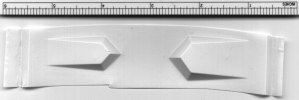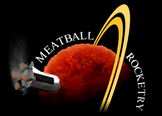The latest design for the J-2 Engines in 1:72 and 1:70 scale is identical to the original, but the 3D model is now printed in two pieces for easier finishing. Note the addition of sprue material that will have to be removed for assembly. (Lower sprue is only partially removed to preserve studs for attachment. Upper sprue should be removed after assembly to limit flexibility.)
J-2 Engines for sale in 1:72 & 1:70 Scale (Updated)
Design Update (1:72 & 1:70)
The latest design for the J-2 Engines in 1:72 and 1:70 scale is identical to the original, but the 3D model is now printed in two pieces for easier finishing. Note the addition of sprue material that will have to be removed for assembly. (Lower sprue is only partially removed to preserve studs for attachment. Upper sprue should be removed after assembly to limit flexibility.)
See our shop for J-2 engines in various sizes and additional scale model parts!
Original Post Feb 11, 2014:
John Love recently purchased a set of our J-2 engines from Shapeways for his 1:72 Saturn V model project. Check them out!
See also the product pages on Shapeways:We have J-2 engines in other scales as well. Check out additional products in our shop.
Protected: Trailblazer II Model by Pete Covell
Protected: Trailblazer II Data & Photos
1:72 and 1:70 H-1 Engine Sets
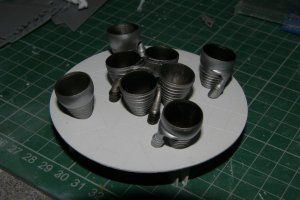 We’re happy to announce our latest 3D-printed parts available via Shapeways: Sets of H-1 Engines in 1:72 and 1:70 scale. Both early and later versions of the central flame shield / inboard turbine exhaust designs are represented alongside a common outboard engine design. Links below. Be sure to check out various photos of 1:72 scale test prints. Special thanks to Tim Brandt for photos of painted parts.
We’re happy to announce our latest 3D-printed parts available via Shapeways: Sets of H-1 Engines in 1:72 and 1:70 scale. Both early and later versions of the central flame shield / inboard turbine exhaust designs are represented alongside a common outboard engine design. Links below. Be sure to check out various photos of 1:72 scale test prints. Special thanks to Tim Brandt for photos of painted parts.
Links:
H-1 Engines SA-5 thru SA-202
1:70 | 1:72 | 1:144 | 1:200
H-1 Engines SA-203 thru SA-210
1:70 | 1:72
H-1 Engines (1:72 Saturn I & IB) SA-5 thru SA-202
H-1 Engines (1:72 Saturn IB) SA-203 thru SA-210
NASA Space Shuttle Columbia (Centuri #5343)
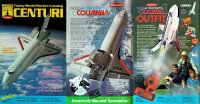 See below for instruction, template, and decal scans for the NASA Space Shuttle Columbia by Centuri (Kit #5343), courtesy of Tim Morley. This was a favorite of mine when I was about 5 years old. Note: The catalog image scans (right) are from ninfinger.org.
See below for instruction, template, and decal scans for the NASA Space Shuttle Columbia by Centuri (Kit #5343), courtesy of Tim Morley. This was a favorite of mine when I was about 5 years old. Note: The catalog image scans (right) are from ninfinger.org.
Click here for entire ZIP Archive of related files.
See gallery images for viewing or saving individual 300 dpi files (Note: TIF instruction sheet scans were converted to PNG to allow for gallery display but are unchanged in ZIP archive.):
Rockets of Childhood

This page highlights many of the rockets that I had growing up, in a more-or-less chronological order. Not every single model is included, but mainly those I consider significant in some way or ones connected with especially fond memories. Not only do I credit my dad for introducing me to model rocketry, but both of my parents are very much to thank for the assembly, painting, and decal work of all of the earlier kits that were given to me. Considering the complexity of some of those models, it says a lot about my parents’ dedication to encouraging their kids’ interests.
The following entries are incomplete. This page will be updated as time allows.
Astron Farside – c. 1981
 The flight of my dad’s 3-stage Farside, in addition to the first space shuttle flight, was a primary source of inspiration for a life-long interest in rocketry. My earliest rocketry memories are of my dad showing me the unpainted kit and demonstrating the staging sequence when I was only four, then the flight at a local school. See more information about this and subsequent Farside builds on our Astron Farside page.
The flight of my dad’s 3-stage Farside, in addition to the first space shuttle flight, was a primary source of inspiration for a life-long interest in rocketry. My earliest rocketry memories are of my dad showing me the unpainted kit and demonstrating the staging sequence when I was only four, then the flight at a local school. See more information about this and subsequent Farside builds on our Astron Farside page.
Renegade – c. 1981
 After years of wondering, I only recently (2013) discovered the identity of a second rocket from my earliest childhood fleet which may or may not have flown the same day as the Farside. I always remembered fondly (but vaguely) a larger diameter long rocket that my dad had painted orange and black (and may have left the nose cone white and painted black circumferential stripes on it–yeah, I know the stripes sound weird, but my dad once hand-painted brown stripes around an orange Mosquito, so it wouldn’t surprise me if my fuzzy memory is correct). I don’t have any memory of the Renegade flying (I’m pretty sure it did fly at least once), but I seem to recall hitting my younger brother with it like a sword at some point (Estes body tubes aren’t strong enough for that, by the way; I don’t recommend using them for make-believe sword fighting).
After years of wondering, I only recently (2013) discovered the identity of a second rocket from my earliest childhood fleet which may or may not have flown the same day as the Farside. I always remembered fondly (but vaguely) a larger diameter long rocket that my dad had painted orange and black (and may have left the nose cone white and painted black circumferential stripes on it–yeah, I know the stripes sound weird, but my dad once hand-painted brown stripes around an orange Mosquito, so it wouldn’t surprise me if my fuzzy memory is correct). I don’t have any memory of the Renegade flying (I’m pretty sure it did fly at least once), but I seem to recall hitting my younger brother with it like a sword at some point (Estes body tubes aren’t strong enough for that, by the way; I don’t recommend using them for make-believe sword fighting).
NASA Space Shuttle Columbia (Centuri) – c. 1981
 The Centuri Space Shuttle Columbia was the first rocket kit that my parents bought especially for me. The first one flew with an unpainted brown body tube, but the wings were white fiberboard and decals were adhesive-backed paper. We flew it behind our apartment and promptly lost it in a tree, though I think the body was eventually recovered after separating from the shock cord (due to rain/moisture). At some point not long afterward a replacement kit was built. This time it was painted (see photo). I don’t recall if the second model ever flew; I may have used it solely as a toy and for display, and it was likely destroyed by rough handling.
The Centuri Space Shuttle Columbia was the first rocket kit that my parents bought especially for me. The first one flew with an unpainted brown body tube, but the wings were white fiberboard and decals were adhesive-backed paper. We flew it behind our apartment and promptly lost it in a tree, though I think the body was eventually recovered after separating from the shock cord (due to rain/moisture). At some point not long afterward a replacement kit was built. This time it was painted (see photo). I don’t recall if the second model ever flew; I may have used it solely as a toy and for display, and it was likely destroyed by rough handling.
 That kit is probably one of the oddest and least accurate shuttle models ever created, but I have very fond memories of it and would love to own another. Some interesting things about it: the cockpit was a thin vacuum-formed piece of styrene that had to be cemented to the stock nose cone, and the OMS pods were represented by flat fiber fins.
That kit is probably one of the oddest and least accurate shuttle models ever created, but I have very fond memories of it and would love to own another. Some interesting things about it: the cockpit was a thin vacuum-formed piece of styrene that had to be cemented to the stock nose cone, and the OMS pods were represented by flat fiber fins.
Scans of instructions and templates are hosted here courtesy of Tim Morley.
Sky Hook – c. 1982
 My Sky Hook was painted Testors Competition Orange with a flat black nose cone. I kept the nose cone for several years after the body was destroyed. I’ve always liked this simple “classic” rocket style (note the similarity of outline relative to the upper stage of the Farside–probably a connection there).
My Sky Hook was painted Testors Competition Orange with a flat black nose cone. I kept the nose cone for several years after the body was destroyed. I’ve always liked this simple “classic” rocket style (note the similarity of outline relative to the upper stage of the Farside–probably a connection there).
Space Shuttle Columbia (Estes) – c. 1982
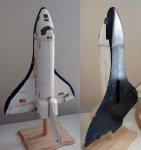 This rocket is an old favorite that I still keep on a shelf. It was built by my parents when I was about 6. Despite drawing payload bay lines in thick magic marker as a kid, it still looks pretty good and has flown a few times in the early 2000s. This model has always had a very graceful flight profile, especially in the coast phase; it always seemed like it wanted to try to glide prior to parachute ejection. I’m fortunate that it never got lost or destroyed while growing up. This is the oldest rocket of my childhood fleet that is still in my possession.
This rocket is an old favorite that I still keep on a shelf. It was built by my parents when I was about 6. Despite drawing payload bay lines in thick magic marker as a kid, it still looks pretty good and has flown a few times in the early 2000s. This model has always had a very graceful flight profile, especially in the coast phase; it always seemed like it wanted to try to glide prior to parachute ejection. I’m fortunate that it never got lost or destroyed while growing up. This is the oldest rocket of my childhood fleet that is still in my possession.
For an up-close-and-personal look at a more recent build of this Estes classic, see this series of posts by Chris Michielssen (external link).
Nova Scout Ship – c. 1984
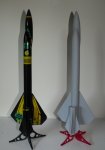 The Nova Scout Ship is the only other rocket (besides the Space Shuttle Columbia) that I still have from early childhood and is also an old favorite. I believe my mom did the bulk of the work on this one. I was also very interested in the Star Ship Nova thanks to prominent image placement in an older catalog, but by the time I actually wanted to find one, it had already been discontinued, although I did get a copy of the Star Ship Nova instructions by writing to Estes.
The Nova Scout Ship is the only other rocket (besides the Space Shuttle Columbia) that I still have from early childhood and is also an old favorite. I believe my mom did the bulk of the work on this one. I was also very interested in the Star Ship Nova thanks to prominent image placement in an older catalog, but by the time I actually wanted to find one, it had already been discontinued, although I did get a copy of the Star Ship Nova instructions by writing to Estes.
I began building a replacement model not that long ago since I had an old nose cone available, scavenged from a damaged Nimbus kit. I redrew the decals in TurboCAD, so they’ll be ready to print when the time comes (I shared my decal file for both model designs with Mark Hayes of Stickershock, so you may be able to get printed or vinyl decals based on my files).
Estes Space Shuttle – c.1984-1985

 I thought this shuttle model was the coolest kit ever from the first time I saw it. My dad was the coolest guy ever for dealing with building it (the vacuum-formed parts can be a real pain).
I thought this shuttle model was the coolest kit ever from the first time I saw it. My dad was the coolest guy ever for dealing with building it (the vacuum-formed parts can be a real pain).
On one of its early flights we lost the tank/booster section to power lines. Thankfully, the shock cord separated and the lower half returned after some rain. My dad replaced the nose with a drill-turned balsa one (it was a bit lopsided, but it worked for us). On a another flight the whole stack crashed, crimping the top of the E.T. body tube a bit and crushing the orbiter’s delicate nose. Eventually I was able to fix it with glue and putty, restoring its flight-worthiness. The cockpit decals had to be replaced with hand-painted ones due, I believe, to some unrelated incident.
I ended up building this kit again myself when I was 13-14. This second model is still in working condition (see recent photo), though I had to repair the motor mount after a minor crash around 2003.
Scorpion 2-Stage
 This was the first rocket kit that I most clearly remember finishing by myself (I may be forgetting others). I recall the fin unit decals giving me extra trouble at the fin roots, leaving a decal bubble “fillet” at every joint. Mine was painted Testors Competition Orange rather than the red displayed on the kit card. The Scorpion probably flew more times than all the other kits I had growing up and was a tough, good-looking bird. We typically flew it with a streamer for easy recovery (the kit came with parachute), but we lost the upper stage around 2003 at a snowy launch with SEVRA. Simple rocket, but significant loss. I have plans to rebuild this one, possibly simulating the one-piece fin units using 3D-printed parts. Our fleet just seems incomplete without a Scorpion on display.
This was the first rocket kit that I most clearly remember finishing by myself (I may be forgetting others). I recall the fin unit decals giving me extra trouble at the fin roots, leaving a decal bubble “fillet” at every joint. Mine was painted Testors Competition Orange rather than the red displayed on the kit card. The Scorpion probably flew more times than all the other kits I had growing up and was a tough, good-looking bird. We typically flew it with a streamer for easy recovery (the kit came with parachute), but we lost the upper stage around 2003 at a snowy launch with SEVRA. Simple rocket, but significant loss. I have plans to rebuild this one, possibly simulating the one-piece fin units using 3D-printed parts. Our fleet just seems incomplete without a Scorpion on display.
Commanche 3
Mercury Redstone
Designer’s Special (Various)
Zeus B-1 (Scratch-built sport model)
Family Rockets
Rockets are just cool enough as a family activity that my brother Aaron and sister Rebecca got into the action, if in a minor way. My brother’s first rocket was the Viking, a small BT-20 rocket with fiber fins and multiple fin layout options. His was painted copper, which looked nice with the bare red plastic nose cone (see photo at the top of the post). He also built a custom metallic blue rocket from my Designer’s Special, then a few years later a Der V-3 kit, which I still keep. Rebecca had a BT-5-sized Sparrow kit which was painted ruby red with a silver nose (see photo) and later a Gnome (pre-colored chrome and blue). I recently gave her a replacement Gnome that she can fly with her kids.
Quick Tip: Engine Blocks and Hooks
Always use engine blocks when using engine hooks.
I have never felt comfortable with the idea of hook-only motor retention, but I didn’t have clear rationale behind my concerns until now. On launch day of rocket camp 2014, one of our students inadvertently pushed his engine (along with the hook!) too far into his Alpha III while installing his igniter plug into the nozzle.
At first I had assumed that the front end of the hook had ripped a slot through the thin-walled BT-20 engine mount tube, allowing it to slide back and forth. But after examining the model more closely at home, it appears that the body tube was only damaged slightly. What seems to have happened (although it’s hard to be absolutely sure by only examining the mount from inside) is that the flexible hook, after pushing open its mounting slit just a little, threaded its way into the inside of the mount. Whether ripped tube or sliding hook, if there had been an engine block in place, no problem would have occured.
The good news is that I was able to fix the student’s Alpha III by gluing a modified engine block in from the top (using a long 1/2″ dowel) and reinforcing the damaged tube from the bottom using thin CA on the end of a narrow stick. His rocket is now stronger than the others, but next time we teach a rocket camp there will be engine blocks for everyone.
Images Added to netfabb Tips for STL Fixing
For those of you interested in designing your own scale model parts and printing them yourself or uploading them to a service such as Shapeways, I finally finished a post of tips-and-tricks for file repair in netfabb Studio Basic (free). There is some mention of TurboCAD-specific settings, but most of the post should be relevant for STL repair in general (your mileage may vary).
NARAM-50
The following are photos we took at NARAM-50 in the scale judging room during viewing. Detailed views of our Saturn I model are posted elsewhere on this site.
The following is raw video from the Scale Judging Room, showing both models and judging sheets. Some random comments and conversations can be heard in the background. WARNING: This video is mostly BORING, and with the old Hi8 tape quality, you won’t see a lot of model details, but you might get a feel for the variety of models present at a NARAM. Different judging sheet colors denote different divisions. Video by Jess.

